First Firing Report
After all the work of the last few weeks, it’s good to finally be on the other side of all of the changes taking place in my little world. Settling into the new studio took a bit longer than expected, but with the first firing now over and done with there is finally a bit of time to stop and look back at the big burn. Thanks to all those folks who helped make it happen, from "loaning" their pottery to help fill the kiln to lifting the pallets.
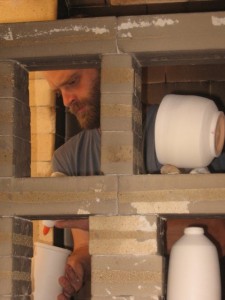
Although I moved my studio to the
EnergyXchange for a lot of reasons, one of the main ones was the fact that there would be a wood fired soda kiln to use. Approaching a brand new kiln that has never been fired before, one is simultaneously drawing on all the knowledge of previous firings in previous kilns, observing and calculating and pontificating, and also flying by the seat of one’s pants.
That would be for a typical kiln.
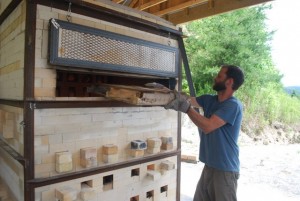
This kiln being quite unique, there were many worries to listen to and ponder over while waiting for some answers from the first go ‘round. The most commonly recorded questions from the peanut gallery were:
· Won’t the pallets fall into the bagwall and knock it right over?
· Will the pallets get stuck in the ‘mail slot’ on the way in, bursting into flames?
· What about the nails?
I will admit that I too was a doubter at times: although I was confident the kiln would ultimately fire just fine, I was worried about what the iron from the nails would do on the pots. I am happy to report that there are answers to all of these questions, and so far indications look good for future firings.
1. Although I did observe at least one stoke where a pallet sent the bagwall rocking back and forth, it was not as common as some might have predicted to send a pallet straight in to the wall nose first. Once you got the feel of it, not too hard but not too easy either, the pallets went in just right. It was actually much easier to lose the groove while stoking by not launching the pallet with enough ummph, causing the nose of the pallet to drop down short and the tail of the pallet to flip around ass backwards into the bagwall. All said, we lost a few pots off of the bagwall, but not too many.
2. A few pallets did get stuck on the way in, causing a bit of excitement and requiring some rapid response. As with any firing, keeping your wits about you and the right tools handy solved the problem. A quick thump on the stuck pallet with a big piece of metal was enough to take care of it.
3. I was most worried about the nails and I figured it could be the ruin of the whole thing, so I was quite relieved that I saw practically no effect from the nails at all on the pottery.
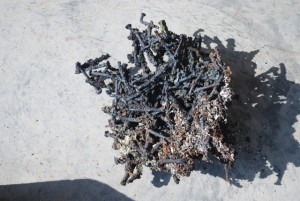
We fired to cone 10 in about 16 hours, burning up at least 115 or so pallets, and we introduced 6 pounds of soda ash on wood near the end of the firing. We saw successful pots coming from about half of the kiln, with good rich colors and soda flashing. The top section was a bit colder and drier, something we can certainly work on for next time.
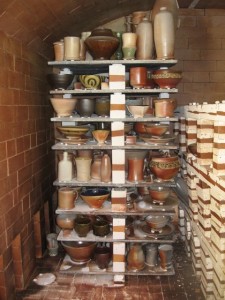
All said, the Mark Peters’ Pallet Eater performed well for the maiden voyage, and I think it will prove to be a fine kiln for wood firing.
 Although I moved my studio to the EnergyXchange for a lot of reasons, one of the main ones was the fact that there would be a wood fired soda kiln to use. Approaching a brand new kiln that has never been fired before, one is simultaneously drawing on all the knowledge of previous firings in previous kilns, observing and calculating and pontificating, and also flying by the seat of one’s pants.
That would be for a typical kiln.
Although I moved my studio to the EnergyXchange for a lot of reasons, one of the main ones was the fact that there would be a wood fired soda kiln to use. Approaching a brand new kiln that has never been fired before, one is simultaneously drawing on all the knowledge of previous firings in previous kilns, observing and calculating and pontificating, and also flying by the seat of one’s pants.
That would be for a typical kiln.
 This kiln being quite unique, there were many worries to listen to and ponder over while waiting for some answers from the first go ‘round. The most commonly recorded questions from the peanut gallery were:
· Won’t the pallets fall into the bagwall and knock it right over?
· Will the pallets get stuck in the ‘mail slot’ on the way in, bursting into flames?
· What about the nails?
I will admit that I too was a doubter at times: although I was confident the kiln would ultimately fire just fine, I was worried about what the iron from the nails would do on the pots. I am happy to report that there are answers to all of these questions, and so far indications look good for future firings.
1. Although I did observe at least one stoke where a pallet sent the bagwall rocking back and forth, it was not as common as some might have predicted to send a pallet straight in to the wall nose first. Once you got the feel of it, not too hard but not too easy either, the pallets went in just right. It was actually much easier to lose the groove while stoking by not launching the pallet with enough ummph, causing the nose of the pallet to drop down short and the tail of the pallet to flip around ass backwards into the bagwall. All said, we lost a few pots off of the bagwall, but not too many.
2. A few pallets did get stuck on the way in, causing a bit of excitement and requiring some rapid response. As with any firing, keeping your wits about you and the right tools handy solved the problem. A quick thump on the stuck pallet with a big piece of metal was enough to take care of it.
3. I was most worried about the nails and I figured it could be the ruin of the whole thing, so I was quite relieved that I saw practically no effect from the nails at all on the pottery.
This kiln being quite unique, there were many worries to listen to and ponder over while waiting for some answers from the first go ‘round. The most commonly recorded questions from the peanut gallery were:
· Won’t the pallets fall into the bagwall and knock it right over?
· Will the pallets get stuck in the ‘mail slot’ on the way in, bursting into flames?
· What about the nails?
I will admit that I too was a doubter at times: although I was confident the kiln would ultimately fire just fine, I was worried about what the iron from the nails would do on the pots. I am happy to report that there are answers to all of these questions, and so far indications look good for future firings.
1. Although I did observe at least one stoke where a pallet sent the bagwall rocking back and forth, it was not as common as some might have predicted to send a pallet straight in to the wall nose first. Once you got the feel of it, not too hard but not too easy either, the pallets went in just right. It was actually much easier to lose the groove while stoking by not launching the pallet with enough ummph, causing the nose of the pallet to drop down short and the tail of the pallet to flip around ass backwards into the bagwall. All said, we lost a few pots off of the bagwall, but not too many.
2. A few pallets did get stuck on the way in, causing a bit of excitement and requiring some rapid response. As with any firing, keeping your wits about you and the right tools handy solved the problem. A quick thump on the stuck pallet with a big piece of metal was enough to take care of it.
3. I was most worried about the nails and I figured it could be the ruin of the whole thing, so I was quite relieved that I saw practically no effect from the nails at all on the pottery.
 We fired to cone 10 in about 16 hours, burning up at least 115 or so pallets, and we introduced 6 pounds of soda ash on wood near the end of the firing. We saw successful pots coming from about half of the kiln, with good rich colors and soda flashing. The top section was a bit colder and drier, something we can certainly work on for next time.
We fired to cone 10 in about 16 hours, burning up at least 115 or so pallets, and we introduced 6 pounds of soda ash on wood near the end of the firing. We saw successful pots coming from about half of the kiln, with good rich colors and soda flashing. The top section was a bit colder and drier, something we can certainly work on for next time.
 All said, the Mark Peters’ Pallet Eater performed well for the maiden voyage, and I think it will prove to be a fine kiln for wood firing.
All said, the Mark Peters’ Pallet Eater performed well for the maiden voyage, and I think it will prove to be a fine kiln for wood firing.
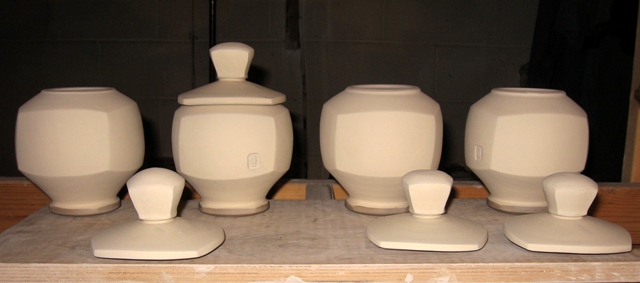
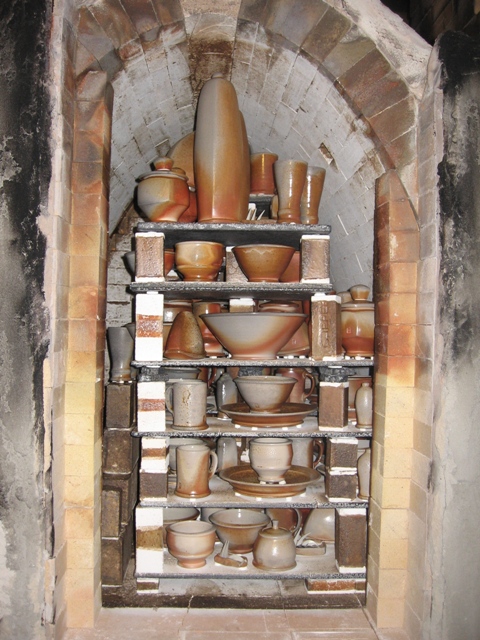
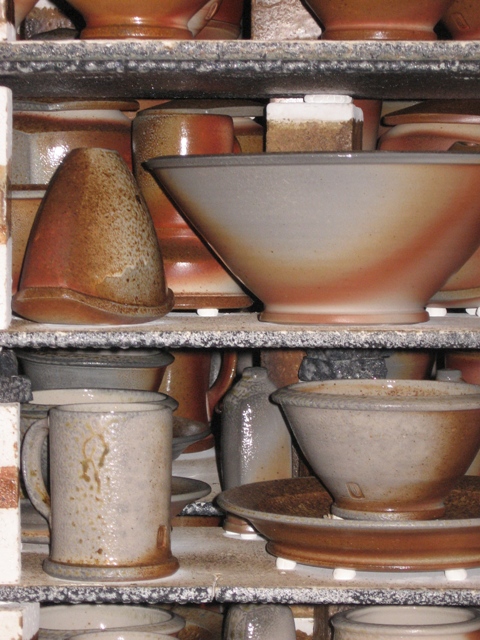
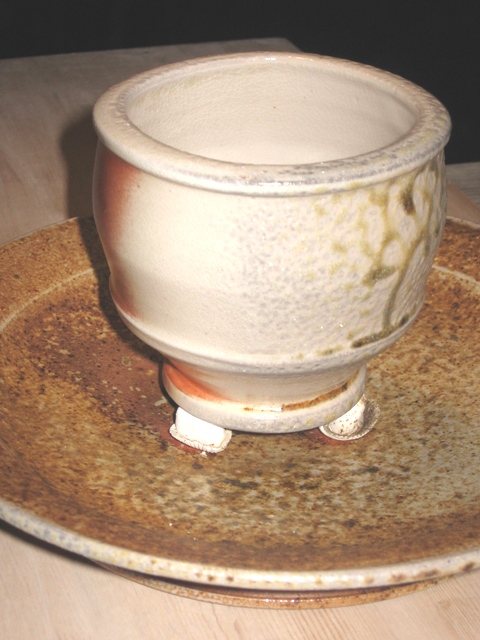


wow – b – it looks to me, that you might have to raid the compost pile next for some bananas – to get some potassium in that kiln. good work. let me know how it goes. happy recycling…